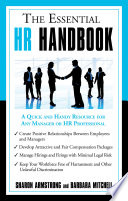

The book begins by establishing the foundational principles of Human Resources (HR). It emphasizes the importance of HR in aligning organizational goals with employee performance. The authors discuss key HR functions such as recruitment, onboarding, training, performance management, and employee relations. Understanding these fundamentals is crucial for HR professionals and managers alike as they navigate the complexities of workforce management. The book highlights that effective HR practices not only enhance employee satisfaction but also drive organizational success. By mastering these HR fundamentals, leaders can create a productive and positive workplace culture.
Continue readingOne of the core components of HR is recruitment. The book delves into strategic recruitment techniques that go beyond traditional hiring practices. It emphasizes the importance of building a strong employer brand to attract top talent and outlines methods for identifying the right candidates who align with the company’s values and culture. The authors provide insights into crafting effective job descriptions, utilizing social media for recruitment, and implementing structured interview processes. By focusing on strategic talent acquisition, organizations can reduce turnover rates and foster a more engaged workforce.
Continue readingThe book stresses the significance of continuous employee development and training as a means of enhancing skills and improving job performance. It discusses various training methods, including on-the-job training, mentorship programs, and e-learning platforms. The authors argue that investing in employee development not only boosts individual performance but also contributes to overall organizational effectiveness. Furthermore, the book emphasizes the role of HR in identifying training needs and creating personalized development plans that align with both employee aspirations and business objectives.
Continue readingEffective performance management is crucial for organizational success, and the book provides a comprehensive overview of best practices in this area. It discusses the importance of setting clear performance expectations, conducting regular performance reviews, and providing constructive feedback. The authors highlight various performance appraisal methods and the need for a continuous feedback loop that encourages employee growth. By fostering a culture of open communication and regular feedback, organizations can improve employee morale and productivity, ultimately leading to better business outcomes.
Continue readingThe book addresses the critical issue of employee engagement and retention, emphasizing that engaged employees are more productive and less likely to leave the organization. It explores strategies for enhancing employee engagement, such as recognizing achievements, promoting work-life balance, and creating opportunities for career advancement. The authors provide case studies and practical tips for implementing engagement initiatives that resonate with employees. By prioritizing engagement and retention, organizations can cultivate a loyal workforce that drives long-term success.
Continue readingHuman Resources professionals must navigate a complex landscape of legal and ethical issues. The book outlines key employment laws and regulations that impact HR practices, including anti-discrimination laws, wage and hour regulations, and workplace safety standards. The authors stress the importance of maintaining compliance and fostering an ethical workplace culture. They provide guidance on how to handle sensitive HR situations, such as employee grievances and disciplinary actions, while ensuring fairness and transparency. Understanding these legal and ethical considerations is vital for HR professionals to mitigate risks and protect the organization.
Continue readingThe book concludes by discussing the transformative role of technology in HR. It explores various HR software solutions that streamline processes such as recruitment, performance management, and employee engagement. The authors highlight the benefits of data analytics in making informed HR decisions and improving overall efficiency. By leveraging technology, HR professionals can automate routine tasks, enhance communication, and gain insights into workforce trends. Embracing technology in HR practices can lead to a more agile and responsive organization.
Continue reading